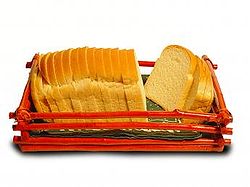Dough conditioner
 |
|
| Main ingredients | Flour, water |
|---|---|
| |
|
A dough conditioner is any ingredient or chemical added to bread dough to strengthen its texture or otherwise improve it in some way. Dough conditioners may include enzymes, yeast nutrients, mineral salts, oxidants and reductants, and emulsifiers.
Examples of dough conditioners include ascorbic acid, distilled monoglycerides, citrate ester of monoglycerides, diglycerides, ammonium chloride, enzymes, diacetyl tartaric acid ester of monoglycerides or DATEM, potassium bromate, calcium salts such as calcium iodate, L-cystine,azodicarbonamide, sodium stearoyl lactylate, sucrose palmitate or sucrose ester, polyoxyethylene sorbitan monostearate or polysorbate, soybean lecithin, and soybean lecithin enriched with lysophospholipids.
Less processed dough conditioners include sprouted- or malted-grain flours, soy, milk, wheat germ, potatoes, gluten, yeast, and extra kneading. Malted, diastatic flours are not typically added by manufacturers to whole-wheat flours. Robertson et al. point out that some of the better information is found in baking books published back when bakers were still kneading by hand.
In the early 1900s it was discovered the use of calcium chlorid [sic], ammonium sulfate, and potassium bromate halved the amount of yeast needed to raise dough. These mixtures were generally known as mineral yeast foods or yeast nutrient salts. After they became popular among bakers, one patented yeast food was analyzed by Connecticut Agricultural Experiment Station chief chemist J.P. Street who published in 1917 that it contained, "calcium sulphate, 25; ammonium chlorid, 9.7; potassium bromate, 0.3; sodium chlorid, 25; patent wheat flour, 40." They contain water conditioners, yeast conditioners, and dough conditioners.
...
Wikipedia
